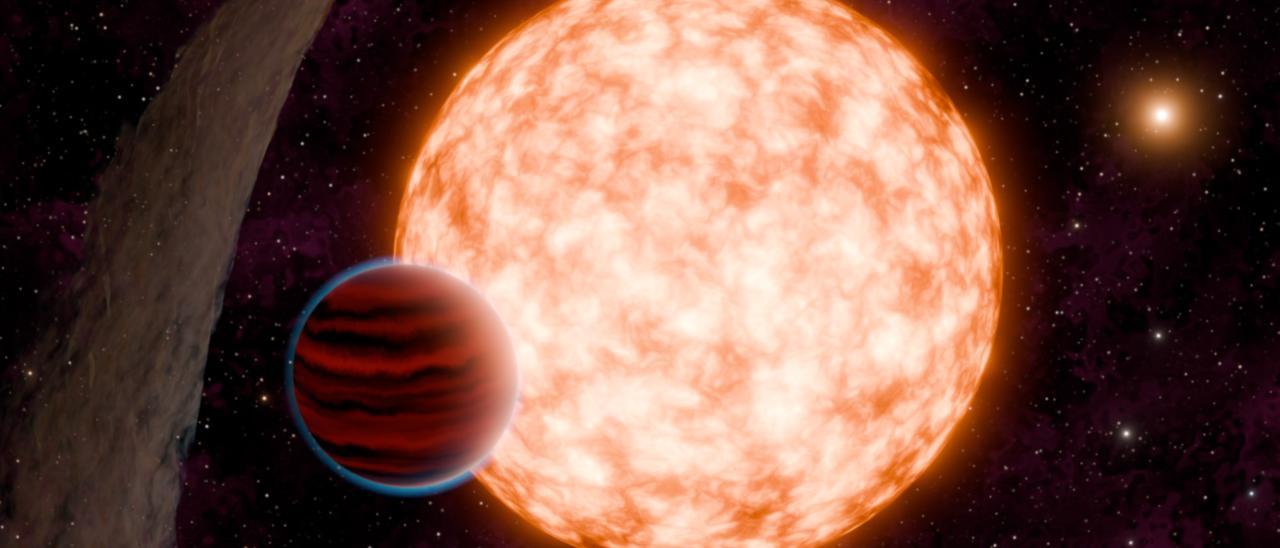Researchers at the Instituto de Astrofísica de Canarias (IAC) in collaboration with other entities, such as NASA, have managed to detect the youngest planet ever found, using the technique of transits. This “baby planet” is paradoxically a giant in orbit round a very young star.
The Principal Investigator of this finding, which has been published in the Journal Nature, is Madyson Barber, of the University of North Caroliona at Chapel Hill. Other authors of the article include Felipe Murgas and Enric Palle of the IAC.
The discovery was made using the technique of transits. This works because if the orbit of a planet passes through the line of sight between the Earth and its star, every time the planet passes across the face of the star it cuts out a small proportion of the light and this regular dip in the star’s brightness can be measured.
Before this discovery the scientists had found more than a dozen planets around stars with ages between 10 and 40 million years using the method of transits. However, using this method younger planets had not been detected, either because such planets had not had time to form completely, or because our view of these planets is blocked by a residual protoplanetary disc, which is a disc of dense gas and dust that surrounds a newly formed star, and from which the planets are formed.
Barber, and the others collaborating in the project, analyzed the data from NASA’s Transiting Exoplanet Survey Satellite (TESS) and observed a young star, only 3 million years old, catalogued as IRAS 04125+2902, which is relatively near to the Earth (522 light yearsaway). This young star, classified as a T Tauri type, is in the Taurus-Auriga star formation region,and still retains part of the gas and dust of its protoplanetary disc around it.
In the observations the researchers found that the external protoplanetary disc surrounding this star is miss-aligned, and is seen almost face on, instead of being in a more inclined position which is more usual statistically. In addition they detected a very weak inner disc. This combination allowed them to observer the transiting protoplanet IRAS 04125+2902 b.

The study showed that this planet has an orbital period of 8.83 days, a radius 10.7 times bigger than that of the Earth, and has a mass approximately 30% of the mass of Jupiter. The authors of the article suggest that the baby planet or protoplanet could be a predecesor to “super-Earths” or to “sub-Neptunes”, which are often found orbiting stars on the main sequence: those which are burning hydrogen. They infer this because the planet is still in the process of contraction, and its final size is expected to be smaller than its presently measured size.
Given the youth of this star and of the new planet, the favourable geometry of the disc and the relative proximity to the Earth, the authors suggest that this system could be useful for the study of the early stages of the formation of planets. The researcher Enric Pallé explains that “This planet can help us to understand the first stages of the evolution of planetary atmospheres, because it is during the first years of formation when a major part (or even all) of these atmospheres can be los tinto space, due to interaction with the host star. This determines the type of planets which we find after these first formation phases”
Felipe Murgas considers that “This planet and its immediate environment is a valuable piece of the puzzle of planetary formation. As it has an age of only 3 million years, we can infer that planets can form during a short time interval. In addition, as its transit is so well defined we can state clearly that even as young as this planets can have a clearly defined spherical shape, quite different from that of a cloud of dust and gas around the planet itself. All of this helps us to adjust our theoretical modles of planet formation to better confront theory with observations.
NASA’s TESS satellite began operating in 2018 and it is in the process of mapping the whole sky in its search for exoplanets using the transit method. The TESS mission needs the collaboration of many institutions and telescopes to confirm the candidates which it finds, and to determine their properties. In this context the Las Cumbres Observatory Global Telescope (LCOGT) participates in the validation of candidate planets found by TESS, using its network of robotic telescopes installed in several countries, including the Teide Observatory in Tenerife. The transit of IRAS 04125+2902 b was confirmed by observations of transits carried out by telescopes belonging to the LCOGT.
Article: https://www.nature.com/articles/s41586-024-08123-3
Contacts IAC:
Felipe Murgas: fmurgas [at] iac.es (fmurgas[at]iac[dot]es)
Enric Pallé: epalle [at] iac.es (epalle[at]iac[dot]es)
